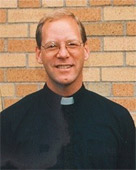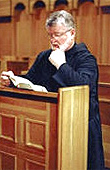 |
 |
 |
 |
|
|
|
|
 |
 |
 |
|
|
What the Church Teaches
What the Catechism of the Catholic ChurchTeaches Regarding the Priesthood and Religious Life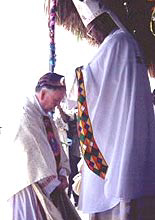 In 1992, Pope John Paul II officially promulgated
the Catechism of the Catholic Church.
The Holy Father intended it to serve as a "sure
norm" for teaching the Catholic faith. A
compendium of all Catholic doctrine regarding
both faith and morals, the Catechism "systematically
presents the teaching of Sacred Scripture,
the living Tradition in the Church and the
authentic Magisterium, as well as the spiritual
heritage of the Fathers, Doctors and saints
of the Church, to allow for a better knowledge
of the Christian mystery and for enlivening
the faith of the People of God." In 1992, Pope John Paul II officially promulgated
the Catechism of the Catholic Church.
The Holy Father intended it to serve as a "sure
norm" for teaching the Catholic faith. A
compendium of all Catholic doctrine regarding
both faith and morals, the Catechism "systematically
presents the teaching of Sacred Scripture,
the living Tradition in the Church and the
authentic Magisterium, as well as the spiritual
heritage of the Fathers, Doctors and saints
of the Church, to allow for a better knowledge
of the Christian mystery and for enlivening
the faith of the People of God."
The following are excerpts from the Catechism of the Catholic Church regarding the priesthood and the consecrated (religious) life. The bold-faced numbers are the paragraph citations from the Catechism. To review a complete online version of the text, visit www.vatican.va. The Sacrament of Holy Orders in the Economy of SalvationThe priesthood of the Old Covenant 1539 The chosen people was constituted by God as "a kingdom of priests and a holy nation." But within the people of Israel, God chose one of the twelve tribes, that of Levi, and set it apart for liturgical service; God himself is its inheritance. A special rite consecrated the beginnings of the priesthood of the Old Covenant. The priests are "appointed to act on behalf of men in relation to God, to offer gifts and sacrifices for sins." 1540 Instituted to proclaim the Word of God and to restore communion with God by sacrifices and prayer, this priesthood nevertheless remains powerless to bring about salvation, needing to repeat its sacrifices ceaselessly and being unable to achieve a definitive sanctification, which only the sacrifice of Christ would accomplish. 1541 The liturgy of the Church, however, sees in the priesthood of Aaron and the service of the Levites, as in the institution of the seventy elders, a prefiguring of the ordained ministry of the New Covenant. Thus in the Latin Rite the Church prays in the consecratory preface of the ordination of bishops:
God the Father of our Lord Jesus Christ .
. .
by your gracious word you have established the plan of your Church. From the beginning, you chose the descendants of Abraham to be your holy nation. You established rulers and priests and did not leave your sanctuary without ministers to serve you. . . . 1542 At the ordination of priests, the Church prays:
Lord, holy Father . . .
when you had appointed high priests to rule your people, you chose other men next to them in rank and dignity to be with them and to help them in their task. . . . you extended the spirit of Moses to seventy wise men. . . . You shared among the sons of Aaron the fullness of their father's power. 1543 In the consecratory prayer for ordination of deacons, the Church confesses:
Almighty God . . .
You make the Church, Christ's body, grow to its full stature as a new and greater temple. You enrich it with every kind of grace and perfect it with a diversity of members to serve the whole body in a wonderful pattern of unity. You established a threefold ministry of worship and service, for the glory of your name. As ministers of your tabernacle you chose the sons of Levi and gave them your blessing as their everlasting inheritance. The one priesthood of Christ 1544 Everything that the priesthood of the Old Covenant prefigured finds its fulfillment in Christ Jesus, the "one mediator between God and men." The Christian tradition considers Melchizedek, "priest of God Most High," as a prefiguration of the priesthood of Christ, the unique "high priest after the order of Melchizedek"; "holy, blameless, unstained," "by a single offering he has perfected for all time those who are sanctified," that is, by the unique sacrifice of the Cross. 1545 The redemptive sacrifice of Christ is unique, accomplished once for all; yet it is made present in the Eucharistic sacrifice of the Church. The same is true of the one priesthood of Christ; it is made present through the ministerial priesthood without diminishing the uniqueness of Christ's priesthood: "Only Christ is the true priest, the others being only his ministers." Two participations in the one priesthood of Christ 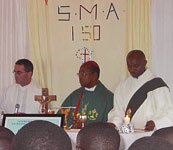 1546 Christ, high priest and unique mediator, has made of the Church "a kingdom, priests for his God and Father." The whole community of believers is, as such, priestly. The faithful exercise their baptismal priesthood through their participation, each according to his own vocation, in Christ's mission as priest, prophet, and king. Through the sacraments of Baptism and Confirmation the faithful are "consecrated to be . . . a holy priesthood." 1546 Christ, high priest and unique mediator, has made of the Church "a kingdom, priests for his God and Father." The whole community of believers is, as such, priestly. The faithful exercise their baptismal priesthood through their participation, each according to his own vocation, in Christ's mission as priest, prophet, and king. Through the sacraments of Baptism and Confirmation the faithful are "consecrated to be . . . a holy priesthood." 1547 The ministerial or hierarchical priesthood of bishops and priests, and the common priesthood of all the faithful participate, "each in its own proper way, in the one priesthood of Christ." While being "ordered one to another," they differ essentially. In what sense? While the common priesthood of the faithful is exercised by the unfolding of baptismal grace — a life of faith, hope, and charity, a life according to the Spirit — , the ministerial priesthood is at the service of the common priesthood. It is directed at the unfolding of the baptismal grace of all Christians. The ministerial priesthood is a means by which Christ unceasingly builds up and leads his Church. For this reason it is transmitted by its own Sacrament, the Sacrament of Holy Orders. In the person of Christ the Head . . . 1548 In the ecclesial service of the ordained minister, it is Christ himself who is present to his Church as Head of his Body, Shepherd of his flock, High Priest of the redemptive sacrifice, Teacher of Truth. This is what the Church means by saying that the priest, by virtue of the sacrament of Holy Orders, acts in persona Christi Capitis:
It is the same priest, Christ Jesus, whose sacred person his minister truly represents. Now the minister, by reason of the sacerdotal consecration which he has received, is truly made like to the high priest and possesses the authority to act in the power and place of the person of Christ himself (virtute ac persona ipsius Christi).
Christ is the source of all priesthood: the priest of the old law was a figure of Christ, and the priest of the new law acts in the person of Christ. 1549 Through the ordained ministry, especially that of bishops and priests, the presence of Christ as head of the Church is made visible in the midst of the community of believers. In the beautiful expression of St. Ignatius of Antioch, the bishop is typos tou Patros: he is like the living image of God the Father. 1550 This presence of Christ in the minister is not to be understood as if the latter were preserved from all human weaknesses, the spirit of domination, error, even sin. The power of the Holy Spirit does not guarantee all acts of ministers in the same way. While this guarantee extends to the sacraments, so that even the minister's sin cannot impede the fruit of grace, in many other acts the minister leaves human traces that are not always signs of fidelity to the Gospel and consequently can harm the apostolic fruitfulness of the Church. 1551 This priesthood is ministerial. "That office . . . which the Lord committed to the pastors of his people, is in the strict sense of the term a service."It is entirely related to Christ and to men. It depends entirely on Christ and on his unique priesthood; it has been instituted for the good of men and the communion of the Church. The sacrament of Holy Orders communicates a "sacred power" which is none other than that of Christ. The exercise of this authority must therefore be measured against the model of Christ, who by love made himself the least and the servant of all. "The Lord said clearly that concern for his flock was proof of love for him." . . . "in the name of the whole Church" 1552 The ministerial priesthood has the task not only of representing Christ — Head of the Church — before the assembly of the faithful, but also of acting in the name of the whole Church when presenting to God the prayer of the Church, and above all when offering the Eucharistic sacrifice. 1553 "In the name of the whole Church" does not mean that priests are the delegates of the community. The prayer and offering of the Church are inseparable from the prayer and offering of Christ, her head; it is always the case that Christ worships in and through his Church. The whole Church, the Body of Christ, prays and offers herself "through him, with him, in him," in the unity of the Holy Spirit, to God the Father. The whole Body, caput et membra, prays and offers itself, and therefore those who in the Body are especially his ministers are called ministers not only of Christ, but also of the Church. It is because the ministerial priesthood represents Christ that it can represent the Church. The Consecrated Life914 "The state of life which is constituted by the profession of the evangelical counsels, while not entering into the hierarchical structure of the Church, belongs undeniably to her life and holiness." Evangelical counsels, consecrated life 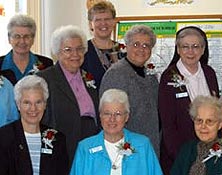 915 Christ proposes the evangelical counsels, in their great variety, to every disciple. The perfection of charity, to which all the faithful are called, entails for those who freely follow the call to consecrated life the obligation of practicing chastity in celibacy for the sake of the Kingdom, poverty and obedience. It is the profession of these counsels, within a permanent state of life recognized by the Church, that characterizes the life consecrated to God. 915 Christ proposes the evangelical counsels, in their great variety, to every disciple. The perfection of charity, to which all the faithful are called, entails for those who freely follow the call to consecrated life the obligation of practicing chastity in celibacy for the sake of the Kingdom, poverty and obedience. It is the profession of these counsels, within a permanent state of life recognized by the Church, that characterizes the life consecrated to God.
916 The state of consecrated life is thus one way of experiencing a "more intimate" consecration, rooted in Baptism and dedicated totally to God. In the consecrated life, Christ's faithful, moved by the Holy Spirit, propose to follow Christ more nearly, to give themselves to God who is loved above all and, pursuing the perfection of charity in the service of the Kingdom, to signify and proclaim in the Church the glory of the world to come. One great tree, with many branches 917 "From the God-given seed of the counsels a wonderful and wide-spreading tree has grown up in the field of the Lord, branching out into various forms of the religious life lived in solitude or in community. Different religious families have come into existence in which spiritual resources are multiplied for the progress in holiness of their members and for the good of the entire Body of Christ." 918 From the very beginning of the Church there were men and women who set out to follow Christ with greater liberty, and to imitate him more closely, by practicing the evangelical counsels. They led lives dedicated to God, each in his own way. Many of them, under the inspiration of the Holy Spirit, became hermits or founded religious families. These the Church, by virtue of her authority, gladly accepted and approved. 919 Bishops will always strive to discern new gifts of consecrated life granted to the Church by the Holy Spirit; the approval of new forms of consecrated life is reserved to the Apostolic See. The eremitic life 920 Without always professing the three evangelical counsels publicly, hermits "devote their life to the praise of God and salvation of the world through a stricter separation from the world, the silence of solitude and assiduous prayer and penance." 921 They manifest to everyone the interior aspect of the mystery of the Church, that is, personal intimacy with Christ. Hidden from the eyes of men, the life of the hermit is a silent preaching of the Lord, to whom he has surrendered his life simply because he is everything to him. Here is a particular call to find in the desert, in the thick of spiritual battle, the glory of the Crucified One. Consecrated virgins and widows 922 From apostolic times Christian virgins and widows, called by the Lord to cling only to him with greater freedom of heart, body, and spirit, have decided with the Church's approval to live in the respective status of virginity or perpetual chastity "for the sake of the Kingdom of heaven." 923 "Virgins who, committed to the holy plan of following Christ more closely, are consecrated to God by the diocesan bishop according to the approved liturgical rite, are betrothed mystically to Christ, the Son of God, and are dedicated to the service of the Church." By this solemn rite (Consecratio virginum), the virgin is "constituted . . . a sacred person, a transcendent sign of the Church's love for Christ, and an eschatological image of this heavenly Bride of Christ and of the life to come." 924 "As with other forms of consecrated life," the order of virgins establishes the woman living in the world (or the nun) in prayer, penance, service of her brethren, and apostolic activity, according to the state of life and spiritual gifts given to her. Consecrated virgins can form themselves into associations to observe their commitment more faithfully. Religious life 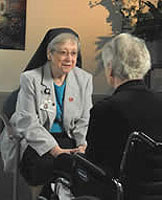 925 Religious life was born in the East during the first centuries of Christianity. Lived within institutes canonically erected by the Church, it is distinguished from other forms of consecrated life by its liturgical character, public profession of the evangelical counsels, fraternal life led in common, and witness given to the union of Christ with the Church. 925 Religious life was born in the East during the first centuries of Christianity. Lived within institutes canonically erected by the Church, it is distinguished from other forms of consecrated life by its liturgical character, public profession of the evangelical counsels, fraternal life led in common, and witness given to the union of Christ with the Church.
926 Religious life derives from the mystery of the Church. It is a gift she has received from her Lord, a gift she offers as a stable way of life to the faithful called by God to profess the counsels. Thus, the Church can both show forth Christ and acknowledge herself to be the Savior's bride. Religious life in its various forms is called to signify the very charity of God in the language of our time. 927 All religious, whether exempt or not, take their place among the collaborators of the diocesan bishop in his pastoral duty. From the outset of the work of evangelization, the missionary "planting" and expansion of the Church require the presence of the religious life in all its forms. "History witnesses to the outstanding service rendered by religious families in the propagation of the faith and in the formation of new Churches: from the ancient monastic institutions to the medieval orders, all the way to the more recent congregations." Secular institutes 928 "A secular institute is an institute of consecrated life in which the Christian faithful living in the world strive for the perfection of charity and work for the sanctification of the world especially from within." 929 By a "life perfectly and entirely consecrated to [such] sanctification," the members of these institutes share in the Church's task of evangelization, "in the world and from within the world," where their presence acts as "leaven in the world." "Their witness of a Christian life" aims "to order temporal things according to God and inform the world with the power of the gospel." They commit themselves to the evangelical counsels by sacred bonds and observe among themselves the communion and fellowship appropriate to their "particular secular way of life." Societies of apostolic life 930 Alongside the different forms of consecrated life are "societies of apostolic life whose members without religious vows pursue the particular apostolic purpose of their society, and lead a life as brothers or sisters in common according to a particular manner of life, strive for the perfection of charity through the observance of the constitutions. Among these there are societies in which the members embrace the evangelical counsels" according to their constitutions. Consecration and mission: proclaiming the King who is coming
932 In the Church, which is like the sacrament — the sign and instrument — of God's own life, the consecrated life is seen as a special sign of the mystery of redemption. To follow and imitate Christ more nearly and to manifest more clearly his self-emptying is to be more deeply present to one's contemporaries, in the heart of Christ. For those who are on this "narrower" path encourage their brethren by their example, and bear striking witness "that the world cannot be transfigured and offered to God without the spirit of the beatitudes." 933 Whether their witness is public, as in the religious state, or less public, or even secret, Christ's coming remains for all those consecrated both the origin and rising sun of their life:
For the People of God has here no lasting city, . . . [and this state] reveals more clearly to all believers the heavenly goods which are already present in this age, witnessing to the new and eternal life which we have acquired through the redemptive work of Christ and preluding our future resurrection and the glory of the heavenly kingdom.
|
|
||||||||||||||||||||||||||||||||
|
|

|

|
|
||||||||||||||||||||||||||||||||
|
|
|||||||||||||||||||||||||||||||||||
| MPD Home Page |
Self-Assessment Survey |
How It Works |
Using the MPD as a Tool
FAQ | Testimonials | Vocation Prayers | What the Church Teaches | Contact us Copyright © Vocations Placement Service, Inc. | |||||||||||||||||||||||||||||||||||


